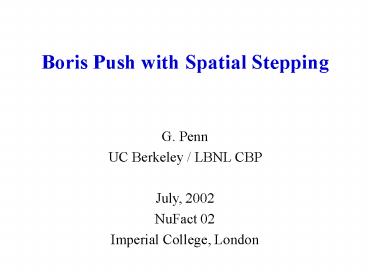G. Penn - PowerPoint PPT Presentation
Title:
G. Penn
Description:
It uses a leapfrog scheme, where the particle is moved, then half of ... less savings for curvilinear (where even field-free is complicated) Muon Collaboration ... – PowerPoint PPT presentation
Number of Views:19
Avg rating:3.0/5.0
Title: G. Penn
1
Boris Push with Spatial Stepping
G. Penn UC Berkeley / LBNL CBP July,
2002 NuFact 02 Imperial College, London
2
Outline
- Boris particle push
- Spatial Boris Push Equations
- advantages of Boris push
- Stability and Accuracy
- Comparison with Runge-Kutta
3
Boris Push
The Boris push is commonly used in plasma physics
simulations because of its speed and
stability. It uses a leapfrog scheme, where the
particle is moved, then half of the energy
changed is applied. After this, the momentum is
rotated by the B field, and the rest of the
energy change applied. The rotation is
automatically energy conserving, and the
algorithm is symmetric to time reversal, which
improves the performance. Second order accurate,
but requires only one field evaluation per time
step. The Boris push is rarely used for
accelerator simulations, because it is more
convenient to propagate particles in z.
4
Spatial Boris Push
In collab. with P. Stoltz, J. Cary, at Tech-X (
U. Colorado, Boulder) The spatial Boris scheme
exchanges U for pz and t for z First, we
replace the equation for pz with the equation
for U Replacing t with z, the governing
equations of the spatial Boris scheme are
5
Decomposition (1)
- For spatial Boris push, the equations separate
into terms that directly change pz and terms that
dont - In the temporal Boris scheme, the separation is
into one piece that changes U (E-fields) and one
that doesnt (B-fields) - The terms that directly change pz are Ez, Bx, and
By - For simplicity, rewrite
6
Decomposition (2)
The Boris scheme integrates vector and matrix
terms separately The Boris scheme says first
push the vector term one-half step Then push
the matrix term a full step Finally, push the
vector term the final half step
This step is implicit and requires some more
massaging
7
Explicit Expression for Boris Push
Step-centered push of matrix term is 2nd-order
accurate Because M is constant, a step-centered
scheme will be 2nd-order accurate Solving for w
gives (IR) w-, R
8
Integration Cycle
Boris push the vector term one-half step
Evaluate Fields
Start
Leap-frog push the positions one-half step
Boris push the matrix term a full step
Leap-frog push the positions one-half step
End
Boris push the vector term the final half step
9
Boris Push speeds up particle tracking
- Spatial motion is calculated a 1/2 step off from
momentum/energy evolution - typically, use leap-frog
- in ICOOL, split into two half-steps,
- before and after evolution of w.
- Fields are only evaluated once, where momentum
kick is applied - compared to 4 field evaluations for RK
- local effect on particle, so almost indep. of
coordinates - track as if no field, then replace ?z with
separation between planes - (now a function of transverse co-ords)
- As in RK, assumes small energy loss per step.
10
Boris Push is Space-Symmetric
- except ionization energy loss, scatter, are
applied at end of step - Second-order conservation of energy
- also canonical momentum when applicable
- robust for large stepsizes
- Errors tend to average out
- in RK scheme, errors will slowly accumulate
- Both schemes work well for small phase advances,
but Boris push - is simpler to calculate
- especially if field calculations are expensive
- less savings for curvilinear (where even
field-free is complicated)
11
Error Scaling
- Comparison of Runge-Kutta with Boris, for
conserved quantities - Runge Kutta is approx fifth order accurate
(special case, solenoid?) - tends to yield slowly increasing errors.
- Boris push only second order, but preserves
invariants - maximum error, e, reached in 1 betatron
oscillation (or cell period) - Relevant length scale is L, step size is D
- RK e R0 (DR / L)5 z / L note exponent 5,
not 4 - Boris max e B0 (DB / L)2
- with 4 x more field calculations per step for RK,
- Boris is faster when acceptable to have e gt B05/3
R0-2/3 (L / z)2/3
12
Examples
10 T Uniform Solenoid conserves P 40 cm for p
phase advance after 400 m, crossover point is
e 2 x 10-5 well below fluctuations for an
ensemble of 106 particles FOFO lattice 1 m
half-period with B2 T, P200 MeV/c well above
cutoff momentum after 400 meters, crossover point
is roughly the same, e 3 x 10-5 For minimum
step sizes fixed by other concerns (e.g.,
scattering), Boris step is 4 x faster and may
still be more accurate
13
Boris push errors
14
Runge Kutta errors
15
Runge Kutta errors
16
References
- P. H. Stoltz, G. Penn, J. Wurtele, and J. R.
Cary, MC Note 229. - J. Boris, Proc. of the 4th Conf. on Numerical
Simulation of Plasma (NRL, 1970). - A. Dullweber, B. Leimkuhler, and R. McLachlan, J.
Chem. Phys. 15 (1997) 5840.































